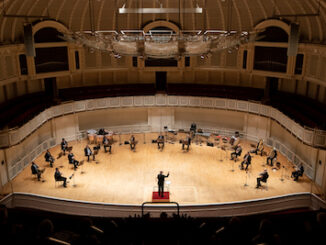
On May 2, 2025, preceded by a first concert May 1st and to be reprised May 3rd and 4th, all at Symphony Center, 220 S. Michigan Ave., Chicago, Chicago Symphony Orchestra Music Director designate Klaus Mäkelä led the CSO and CSO Artist in Residence Daniil Trifonov, piano, in an intriguing and beautifully paced program comprised of the works of great European composers. The concert opened with the guest pianist and Maestro appearing together; these concerts are to be Trifonov’s last of his residency and will stand as a splendid exposition of his mastery.

Chicago Symphony Orchestra; Klaus Mäkelä, Conductor
Daniil Trifonov,Piano; Chopin’s Prelude No. 10 in C-Sharp Minor
Johannes Brahms’ beloved Piano Concerto No. 2 in B-flat Major, Op. 83, 1878-81, is comprised of four movements, beginning with a distinct, clarion horn call seemingly to the Orchestra, which brings forth a graceful melody. The piano responds with such another before setting forth on a virtuoso expansion. Trifonov’s playing is sure, emphasized, yet appears effortless; he neither dominates nor retires. The conductor kept his eyes and firm attentive direction on all instruments as the piano and Orchestra in large ensemble proceed to develop dramatically together, with the horn theme intervening and played by different parts of the Orchestra.
The second movement Scherzo is even more temperamental; filled with drama. Once again, Orchestra and pianist proceed apace, with a thundering exercise for the piano and a contrasting sympathetic mellow theme for the strings. The beauteous slow movement is based on a solo cello motif, moving through the violins before a glorious expansion by Trifonov. The Rondo finale was brilliant, gentle, melodic, building to dual climaxes, retreating, and ascending to a shattering close.
In encore, Trifonov performed Frederic Chopin’s moment-long Prelude No. 10 in C-sharp minor, Op. 28, 1835-39, a standalone piece, entire unto itself, conceived “from the circle of fifths”. Marked molto allegro, it is light-hearted, reminiscent of a flutter of butterfly wings.
After the intermission, Pierre Boulez’ Initiale for Brass Septet, 1987, was a 5-minute complex fanfare, kaleidoscopically varied in tempo, highly angular, deftly directed and performed with a clarity of texture and open dynamics. Punchy and vigorous, the chorale was well-mannered and impressive, almost hypnotizing.

Klaus Mäkelä, Conductor, Boulez, Initiale
Antonin Dvořák’s Symphony No. 7 in D Minor, Op. 70, 1884-85, is a piece imbued with great emotion and theatrical power, and Mäkelä, supremely confident and animated at the helm, obviously had a clear vision of the full 38-minute diorama of a symphony, impassioned, lucid, unsparing in attention to detail.
The first movement begins with a striking theme which seems to be encased in fog, then alternates with a happier melody. The slower second movement unveils itself reverentially, with a chorale in the winds, sweet strings and a lovely flute solo. Then the mood darkens, meanders, and returns to the uplifting and melodic. The third movement Scherzo is based on an upbeat Czech folk dance; led by Mäkelä’s rhythmic baton, enthusiastic upbeat cross-rhythms call forth bending and turning revelers. Ultimately, the Finale, beginning ambiguously, harks back to the majesty of the opening, the beatitude of the Adagio, and the joy of the Scherzo, culminating in a spiritually significant dignified close.
The audience was fully taken by the power of the great Orchestra harnessed by the sheer muscular drive and high-spirited force of the Maestro. We look forward to many great seasons ahead under his direction.
All photos by Todd Rosenberg Photography.
For information and tickets to all the fine programming of The Chicago Symphony Orchestra, go to www.cso.org




1 Trackback / Pingback